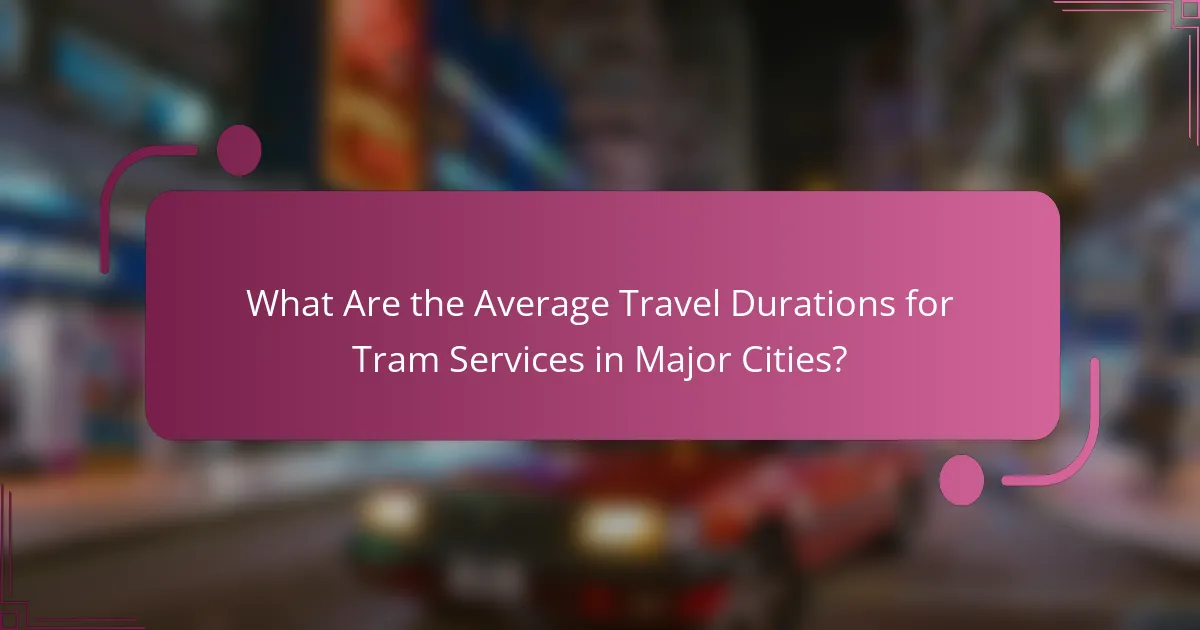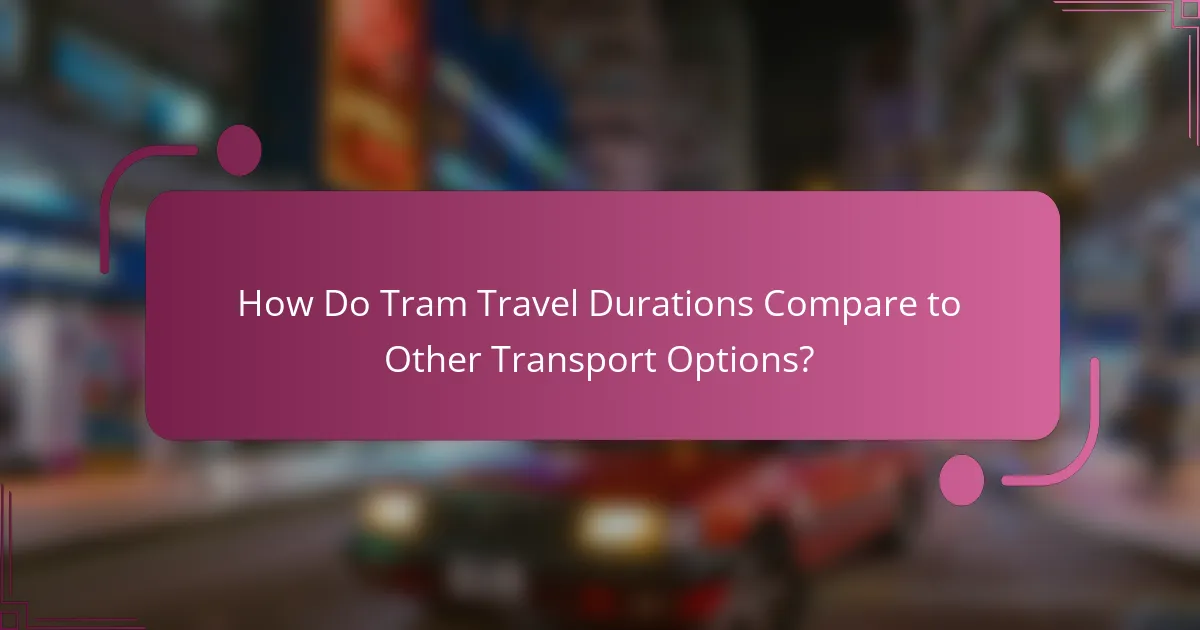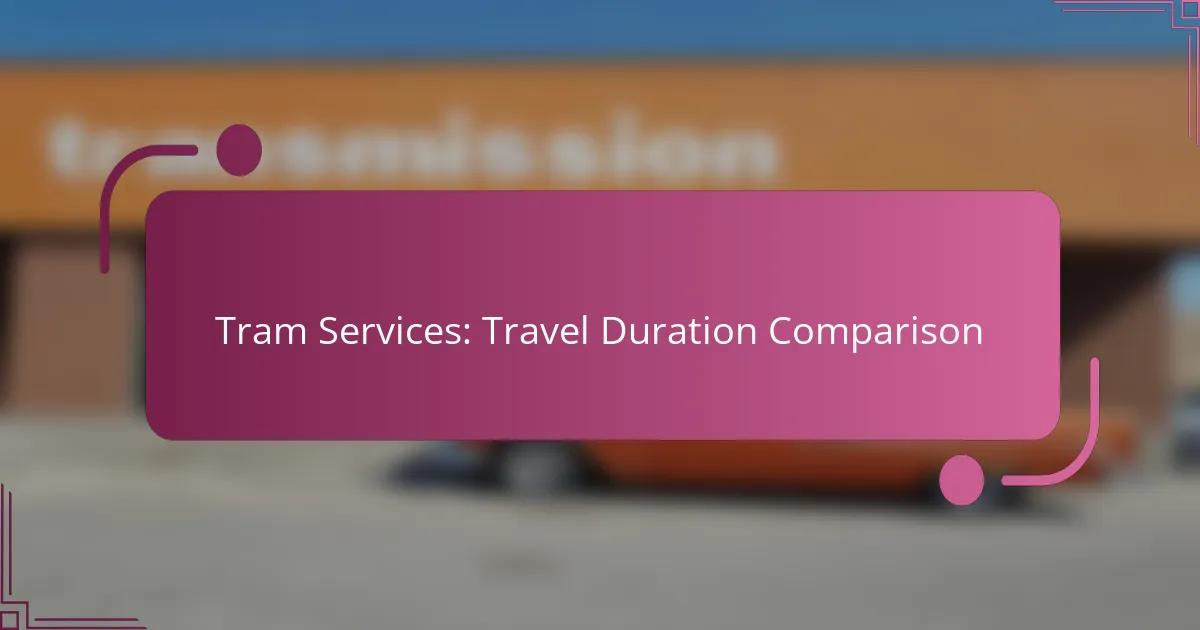Tram services offer a unique travel experience, with average durations varying significantly across major cities due to factors such as route length, frequency, and urban density. By comparing tram travel times to other modes of transport like buses and subways, travelers can gain insights into the efficiency and reliability of trams. Understanding these variables can aid in better journey planning and time management.

What Are the Average Travel Durations for Tram Services in Major Cities?
The average travel durations for tram services vary significantly across major cities, influenced by factors such as route length, frequency, and urban density. Understanding these durations can help travelers plan their journeys more effectively.
New York City Tram Travel Duration
In New York City, tram services like the Roosevelt Island Tramway typically take about 4-5 minutes for a one-way trip. This service offers a unique aerial view of the city, connecting Roosevelt Island to Manhattan.
While the tram is efficient, consider that it operates less frequently during off-peak hours, which may extend your total travel time if you miss a ride. Always check the schedule ahead of time to minimize waiting.
London Tram Travel Duration
London’s tram services, particularly those in Croydon, generally have travel durations ranging from 15-30 minutes depending on the route. The trams are integrated with the city’s transport network, making transfers to buses and trains relatively straightforward.
Keep in mind that peak hours can lead to delays, so plan your journey accordingly. Using an Oyster card or contactless payment can speed up boarding times and enhance convenience.
Melbourne Tram Travel Duration
Melbourne boasts one of the largest tram networks in the world, with average travel durations between 10-30 minutes for most routes. The trams are a popular choice for both locals and tourists, providing access to key attractions.
During peak hours, trams can become crowded, which may affect travel times. Consider using the tram tracker app for real-time updates on arrivals and delays to optimize your travel experience.
San Francisco Tram Travel Duration
In San Francisco, the iconic cable cars typically take around 15-20 minutes for a full route, depending on traffic and stops. These trams not only serve as a mode of transport but also as a tourist attraction, offering scenic views of the city.
Be aware that the cable cars can be subject to delays due to their popularity. If you’re in a hurry, consider alternative transit options like buses or the Muni Metro for quicker travel times.
Berlin Tram Travel Duration
Berlin’s tram services usually have travel durations of about 10-25 minutes, depending on the distance and route. The trams are well-integrated into the city’s public transport system, making them a reliable option for getting around.
To avoid delays, especially during peak hours, check the BVG app for real-time updates and plan your journey accordingly. Using a day pass can also be cost-effective if you plan to travel multiple times in a day.

How Do Tram Travel Durations Compare to Other Transport Options?
Tram travel durations can vary significantly compared to buses, subways, and taxis, often depending on the city and route. Generally, trams provide a reliable and efficient mode of transport, but the actual time taken can depend on factors like traffic, stops, and distance.
Tram vs Bus Travel Duration
Trams typically have a faster travel duration than buses, especially in urban areas with dedicated tracks. Buses often face delays due to traffic congestion and frequent stops, whereas trams operate on fixed routes with fewer interruptions.
For example, in cities like Budapest, tram journeys may take around 10-20% less time than equivalent bus routes. However, during peak hours, both modes can experience delays, so checking real-time schedules is advisable.
Tram vs Subway Travel Duration
Subways generally offer quicker travel durations compared to trams, particularly for longer distances. Subways avoid surface-level traffic, allowing for consistent speeds and fewer stops, which can lead to travel times that are significantly shorter.
In metropolitan areas, subway journeys might be completed in half the time of tram rides for similar distances. However, trams can be more convenient for short trips or when subway stations are not nearby.
Tram vs Taxi Travel Duration
Taxis can provide faster travel durations than trams, especially for direct routes without stops. However, taxi times can vary greatly due to traffic conditions and the need for navigation through urban areas.
In cities like Berlin, a taxi might take 15-30% less time than a tram for the same journey, but this comes at a higher cost. For budget-conscious travelers, trams offer a more economical option, albeit with potentially longer travel times.

What Factors Influence Tram Travel Duration?
Tram travel duration is primarily influenced by route length, traffic conditions, frequency of stops, and the time of day. Understanding these factors can help passengers better estimate travel times and plan their journeys more effectively.
Route Length
The length of the tram route significantly impacts travel duration. Longer routes typically take more time to traverse, while shorter routes can be completed quickly. For example, a route spanning 10 kilometers may take around 20-30 minutes, depending on other factors.
When planning a trip, consider the total distance and compare it with the tram’s average speed, which often ranges from 15 to 25 kilometers per hour in urban areas.
Traffic Conditions
Traffic conditions can greatly affect tram travel times, especially in busy urban environments. Trams may encounter delays due to road congestion or other vehicles obstructing their path. In cities with dedicated tram lanes, these delays are often minimized.
During peak hours, travel times can increase by 20-50% compared to off-peak hours. Always check local traffic reports to gauge potential delays before your journey.
Frequency of Stops
The number of stops along a tram route directly influences travel duration. More frequent stops can lead to longer overall travel times, as each stop adds time for boarding and alighting passengers. A route with 10 stops may take significantly longer than one with only 3 stops.
When choosing a tram route, consider how many stops it has and whether express services are available, which may skip certain stops to reduce travel time.
Time of Day
The time of day plays a crucial role in tram travel duration. During rush hours, trams are often more crowded, leading to longer boarding times and potential delays. Conversely, travel during off-peak hours usually results in quicker journeys.
For optimal travel times, aim to use trams outside of peak commuting hours, typically early morning or late evening, when delays are less likely and trams run more efficiently.

What Are the Best Practices for Reducing Tram Travel Time?
To reduce tram travel time effectively, focus on optimizing routes, implementing priority signals, and increasing tram frequency. These strategies can significantly enhance efficiency and improve overall passenger satisfaction.
Optimizing Routes
Optimizing tram routes involves analyzing current paths and identifying areas for improvement. This can include minimizing detours, reducing stops, and ensuring direct connections to key destinations. For instance, a tram line that eliminates unnecessary stops can save passengers several minutes on their journey.
Consider conducting passenger surveys to understand demand patterns. This data can guide adjustments to routes, ensuring they align with where people travel most frequently. Regularly reviewing and updating routes based on usage trends is essential for maintaining efficiency.
Implementing Priority Signals
Priority signals allow trams to have the right of way at intersections, reducing delays caused by traffic. By installing smart traffic lights that detect approaching trams, cities can minimize wait times and improve overall travel speed. This system can cut travel time by several minutes during peak hours.
Collaboration with local traffic authorities is crucial for successful implementation. Ensure that tram priority is integrated into existing traffic management systems to maximize effectiveness. Regular assessments of signal performance can help identify areas needing adjustments.
Increasing Tram Frequency
Increasing tram frequency can significantly reduce wait times for passengers, leading to a more efficient travel experience. Higher frequency means trams arrive more often, which can encourage more people to use the service. Aiming for intervals of 5 to 10 minutes during peak times can enhance ridership.
However, consider the balance between frequency and operational costs. While more trams can improve service, they also require additional resources. Conducting a cost-benefit analysis can help determine the optimal frequency that meets demand without overspending.

How Do Local Regulations Affect Tram Travel Durations?
Local regulations significantly impact tram travel durations by dictating operational standards, safety protocols, and scheduling practices. These regulations can vary widely between cities and countries, influencing how quickly trams can operate and how often they run.
Traffic Management Policies
Traffic management policies play a crucial role in determining tram travel durations. In cities where trams have dedicated lanes, travel times can be significantly reduced compared to areas where trams share roads with other vehicles. For instance, cities like Amsterdam benefit from extensive tram networks with minimal traffic interference, leading to faster travel times.
Conversely, in regions with less organized traffic systems, trams may face delays due to congestion. Understanding local traffic regulations can help passengers anticipate potential delays and plan their journeys accordingly.
Safety Regulations
Safety regulations are essential for ensuring passenger safety but can also affect tram travel durations. For example, stringent safety checks may require trams to slow down in certain areas, particularly near crossings or in high-density zones. These regulations are designed to prevent accidents but can lead to longer travel times.
Passengers should be aware that safety protocols can vary by location. In some cities, trams may stop more frequently for safety inspections, impacting overall travel duration.
Scheduling and Frequency Rules
Scheduling and frequency rules established by local transit authorities directly influence tram travel durations. Cities with more frequent tram services typically experience shorter wait times and quicker overall travel. For example, in cities like Zurich, trams run every few minutes, allowing for efficient travel across the city.
In contrast, areas with limited tram schedules may require longer waiting periods, extending the total travel time. Passengers should check local schedules and consider peak and off-peak times to optimize their travel experience.
